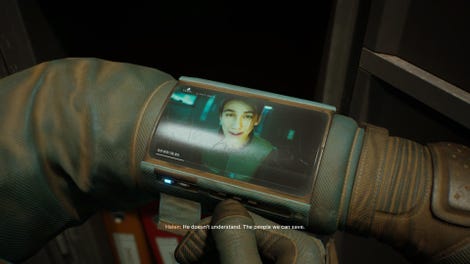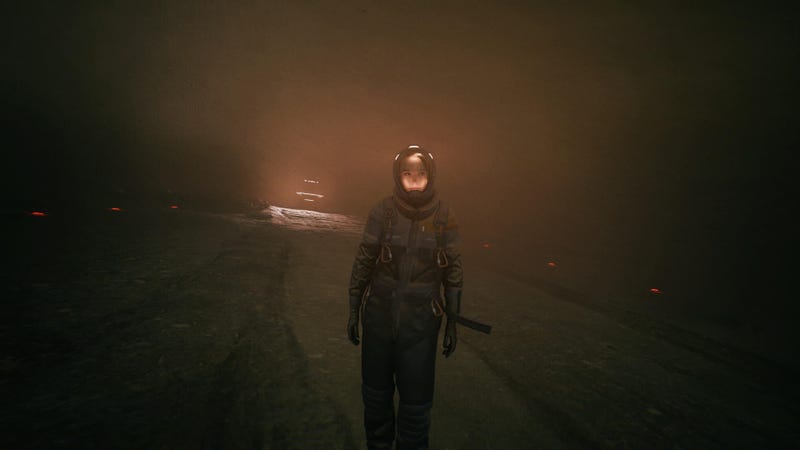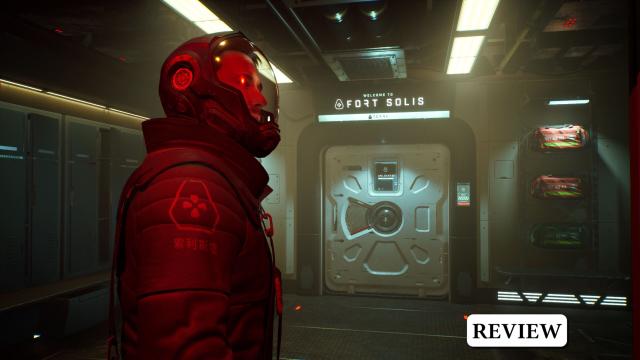Fort Solis feels like running into a barely-remembered ex at the grocery store—nice to look at and unbearably boring. Through its sprightly voice actors’ sheer will, the third-person adventure game sometimes succeeds in its aim to shock you, to do Mars à la Denis Villeneuve, but its story is overall too bovine and garbled. Your mind starts to wander to more important things, like, should I make carbonara for dinner, or…?
From the start, indie developer Fallen Leaf doesn’t give me enough clay to play with. I recognize grouchy engineer Jack Leary (Irish-American Red Dead Redemption II actor Roger Clark) as another man in games’ long line of grizzled engineers—Dead Space’s Isaac Clarke, Team Fortress 2’s Engineer, Final Fantasy IV’s Cid, etc. He’s not complicated or compelling; he’s doing what people presumably do in 2080, bantering about mining shifts and keeping his helmet on, until an alarm at antiquated base Fort Solis requires investigating. Even when slashed, bloodied bodies start to pile up, he’s unwavering in his decision to fix things.

I see Jack’s crewmate Jessica (Julia Brown) as another in the long line of video game women consigned to being helpful from a safe distance—Oracle in the Batman: Arkham games, Cortana in Halo, Ashley in Resident Evil 4, etc.—as she guides Jack through navigating arcane Fort Solis, that “relic,” as characters continually remind me, through wooly voice comms. She becomes playable in the game’s final two chapters (it has four in total, all around an hour in length), but, like it does with Jack, and especially maniacal medical officer Wyatt (The Last of Us jock Troy Baker), Fort Solis seems hesitant to give her a worthwhile story for fear of being less mysterious.
Secrets, at least, take well to Fallen Leaf’s attractive Mars base, which is chrome and gray with abandoned signs of life. Malfunctioning computer terminals, which I use to unlock doors or piece together webcam logs, sit behind glossy, glass sliding doors next to the dregs of the day, like an unsolved Rubik’s cube Jack futilely twists around and a cold beer he, alternatively, sits with and enjoys.
One small step for walking simulators
That beer is a high point for the game’s action. Fort Solis is in the walking simulator caste. But it, disappointingly, doesn’t take advantage of the undersold genre’s strength—its meditative rhythm that pulls you in, turns you into an anxious cast member like in Layers of Fear or interactive drama The Quarry, imbuing each choice to go back and explore with heavy narrative consequences.
Solis is a straight shot. There are some other things to do, I guess, like download missing base members’ voice memos to my glorified Apple Watch, which also contains some of the worst video game maps I’ve ever encountered.
Seriously. In what appears to be a misguided shot at immersion, Fort Solis makes you look at its itsy maps on Jack and Jessica’s wrist tools from their perspective, so that no amount of zooming in will ever make it take up full, or even a quarter, of your screen. To make things even less intuitive, you have to search through several maps of Fort Solis’ couple of floors to identify the small orange objective marker (if it shows up at all), and the yellow cursor that indicates your location only reacts when you’re standing close to or in front of a named location, making establishing a sense of direction unpleasantly difficult.
There’s also a barrage of quicktime events. I spend a ditzy hour missing a majority of their commands (I am genuinely untalented at hitting square, hitting R1 and down on the left stick, hitting L1 and up on the left stick, and so on)—many of which disrupt a scene’s pacing, including a time where I scale up a ragged wall of Martian rock, which should look fast and cool, but actually makes me feel like I’m rock-climbing on Ambien. But I soon learn that scenes play out as scripted in spite of a failed QTE, and I accept that Jack’s fingers will get crushed with or without me.
With quicktime events so ubiquitous but irrelevant, Fort Solis’ most important gameplay mechanic then becomes the art of walking. But it performs this simple, core act clumsily, too.
Cumbersome space suits weigh Jack and Jessica down. They walk like they’re only just waking up, not alone and terrified while a storm creeps outside the airlock, scattering dust chunks and preventing help from coming soon.
Their tortoise crawl pairs poorly with my confusion over the map, and my playtime ends around five hours only because of how much time I waste reentering dark bathrooms, double-checking that I haven’t made it far enough in the game to open a flaring red, locked door that plagues me, picking up a family photo from someone’s desk expecting it to be a clue. I put it down; there are no clues.
I burn so much time that I almost forget there’s a killer on the loose.

Fort Solis is a thriller with no thrills
Oh yeah, the killer. The bodies—I run into them by accident, finding them slumped over in conference room chairs or leaning against Fort Solis’ stifling white walls. Clark and Brown convey terror well, in measured screams, shudders, and quivering resolutions to keep going. Baker in particular gives an engrossing motion capture performance, balancing camp and realism with a stage actor’s meticulousness.
But after an explosive chase, encounter, or discovery, Jack and Jessica go back to dawdling like newborn deer, pausing to enthuse about a vintage record they find in a vacated bedroom like nothing bad is happening. Like, despite the screaming I swear I heard, they aren’t scared.
I don’t get scared, either. Fort Solis, sluggish and contradictory, gives me no reason to.
Each of its elements are insubstantial, easy to blow away like a dust bunny, including its story that, again, congratulates itself too much for being enigmatic (while being predictable in some unfortunate ways—I think a few bodies I find are the same bearded white man because there are so many of them in this game).
Half asleep, I arrive at the more positive of two endings on a lark, successfully completing a string of quicktime events after hours of skipped quicktime events. The moment is lost on me, anyway. I fastidiously investigate every interactive object, watch every video, and read every note I can find about Fort Solis’ hydroponics experiments twice. But nothing gives me a solid understanding of why anyone died, why the game’s final moments happen, or how I feel about it.
Thinking back on my playthrough, there were positive times where I’d notice myself admiring some of Solis’ design details, like Jessica’s rubbery glove caught in her glinting headlamp as she shielded her face from the smoggy storm, or narrative decisions, like when Jack passed his hand over a murder victim’s open eyes to empathetically close them. But they don’t create a unified image; I can neither value nor reject what I’ve done here. I put Fort Solis down confused and disengaged, with half a mind on my email notifications.
I wanted to go to space. But I’m left, like usual, with earthly disappointment.

Leave a Reply